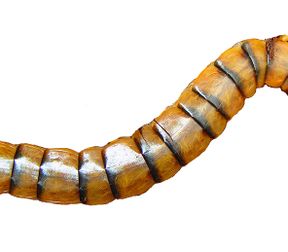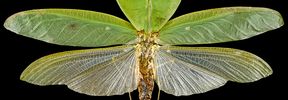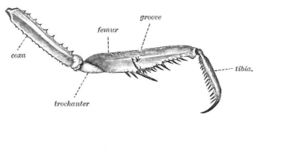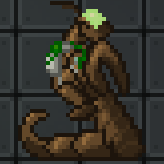Участник:ColdMantis13
Гигантские бронированные серпентиды (ГБС) are a massive predatory species who are trained by a company called Xynergy to work both on and off the SEV Torch. Physically, although they look intimidating, they're unlikely to harm a human except in times of great stress. If you see them getting their large attack arms ready, it's telling you to back off.
Гигантские бронированные серпентиды (ГБС) - это массивный хищный вид, обучением которого занимается компания Xynergy для работы как во многих местах и на многих судах, включая ГЭК "Факел". Физически, хоть они и выглядят запугивающими, но вряд ли навредят человеку, за исключением случаев сильного стресса. Если Вы видите, что они поднимают кверху свои большие атакующие конечности, то это говорит, что Вам надо отступить.
Биология
Анатомия
[[File:Nabber-sketch.jpg|thumb|left| 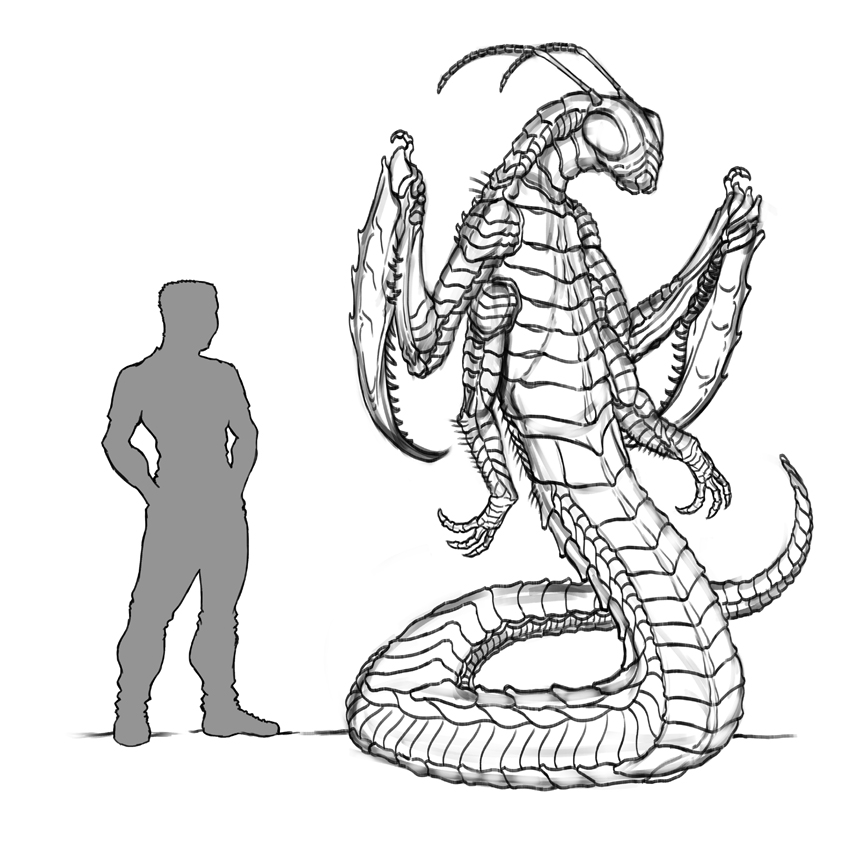 ГБСы гораздо выше людей, возвышаясь на немногим меньше трёх метров над землёй. Они являются артроподами и имеют длинные, змееподобные, сегментированные тела. Каждый из их двух наборов конечностей имеют совершенно разное назначение. Их более крупная, похожая на косы пара рук используется во время охоты, а когда не используется, может быть сложена и плотно прижата к телу. Вторая пара меньше и по пропорциям более схожа с человеческими. У них есть три пальцеобразных лапки, каждая из которых называется именно лапкой, на концах последних сегментов этих рук. Они позволяют им держать и манипулировать инструментами и предметами. Когда их охотничьи руки сложены, они могут вынести свои хватательные руки вперед и нормально их использовать. При использовании охотничьих рук хватающие руки почти невозможно использовать эффективно. Their larger scythelike pair is used for hunting prey and when not in use, can be tucked in and held tightly against their bodies. The second set is smaller and proportioned more similarly to those of humans. They have three fingerlike appendages, each called a tarsus, on the ends of the foremost segment of these arms which allow them to pick up and manipulate tools and objects. These have multiple segments which can bend in both directions, wrapping around whatever they are picking up.
ГБСы гораздо выше людей, возвышаясь на немногим меньше трёх метров над землёй. Они являются артроподами и имеют длинные, змееподобные, сегментированные тела. Каждый из их двух наборов конечностей имеют совершенно разное назначение. Их более крупная, похожая на косы пара рук используется во время охоты, а когда не используется, может быть сложена и плотно прижата к телу. Вторая пара меньше и по пропорциям более схожа с человеческими. У них есть три пальцеобразных лапки, каждая из которых называется именно лапкой, на концах последних сегментов этих рук. Они позволяют им держать и манипулировать инструментами и предметами. Когда их охотничьи руки сложены, они могут вынести свои хватательные руки вперед и нормально их использовать. При использовании охотничьих рук хватающие руки почти невозможно использовать эффективно. Their larger scythelike pair is used for hunting prey and when not in use, can be tucked in and held tightly against their bodies. The second set is smaller and proportioned more similarly to those of humans. They have three fingerlike appendages, each called a tarsus, on the ends of the foremost segment of these arms which allow them to pick up and manipulate tools and objects. These have multiple segments which can bend in both directions, wrapping around whatever they are picking up.
Moving either pair of arms requires both an underlying muscle structure and pressure generated from adjusting the volume of blood in their limbs. The mechanism is functionally similar to that of a hydraulic press and is capable of generating extreme amounts of pressure on anything they're grasping. This power requires them to divert fluid from their manipulation arms to their hunting arms, causing them to drop anything they might have been holding beforehand and rendering them useless for any precise tool using.
Giant armoured serpentids, have a thick exoskeleton which is very strong. It has a series of iridophores over the surface which allows them to adaptively blend into their environment with extreme precision. This requires the precise control the cells, and as such isn’t something they can do consciously. They use this ability in a variety of different ways including camouflage, scaring their enemies, and as a part of a mating display.
GAS have fantastic eyesight, even in very dark conditions due to their two large compound eyes set wide enough on their heads to give them a 360-degree view around them. Each individual section of the compound eye has a tapetum lucidum, a special reflective backing which allows them to see better in the dark in the same way cats do. This, however, makes them vulnerable to sudden bright lights such as flashes. A flash will temporarily blind them and while their vision will mostly recover, without medical attention their eyes will be permanently damaged. Luckily, they have two nearly opaque lenses that they can slide down over their eyes to protect them from bright lights such as fires. Though effective, these lenses make the giant armoured serpentid using them blind farther than about a meter away. They do not use them to blink or to clean their eyes but instead must clean their eyes manually as a part of the grooming process.
The unique oxygen strategy of the giant armoured serpentid relies on using the phoron stored from both the air and from the food they eat. They create acetone using a special organ to extract components from what they eat and the air, mixing it with phoron to create dexalin. This is used to supplement the insufficient oxygen they get from the air around them and enables them to live in areas, like human ships and bases, with even lower oxygen levels and pressure than their home planet. They store sufficient phoron to last for months or years but need to create acetone frequently to maintain their level of dexalin. Theoretically, they wouldn’t need dexalin in an environment with sufficient levels of oxygen at a high enough pressure.
Hunting and Diet
Giant armoured serpentids are omnivorous, eating raw meats and raw vegetables. Grains like wheat or rice, starches like potatoes, fruits, and cooked foods don't agree with them and shouldn't be eaten. They grow their own vegetables using a simplistic farming technique and gather other edible plants that grow close to their colonies.
GAS are also expert hunters and are well adapted for capturing and killing prey up to double their weight. As an ambush predator, they stay completely motionless for long periods of time, waiting for prey to pass. They often position themselves within reach of game trails, their skin hiding them and leaving them effectively invisible. They lay their antennae in front of them across the path and, when an animal passes by, they strike at it to grasp it in their large forelimbs. They then will usually go for the head, using their sharp mandibles to chew open the skull or exoskeleton of their catch. After consuming the head, they will often bring the rest back to share with the colony.
Speech and Formal Language
Giant armoured serpentid language is a mixture of visual and audio signals, though they don’t work together. Rather, the two are independent of each other and the language can be fully understood if you can only hear it or if you can only see it. This is because of the clicking, grinding, and buzzing sounds involved each have a unique mouth movement that produces it. GAS can “read lips” in this fashion or rely on the audio, though the audio component is not as understandable and leads to more mistakes understanding what the other person is saying.
Mammalian, reptilian, or amphibious species would be unlikely to be able to produce the correct sounds and they definitely wouldn’t be able to produce the correct visuals for the language. However, the sounds can be easily reproduced by machines and are easily translatable by translation devices. Because they can’t be pronounced by humans and because the sounds to create them are abstract and without meaning, the names they use for themselves lack an equivalent in human language.
Serpentids also are unable to produce the sounds to speak in any language but their own. Human sign language isn’t possible either as, with only three “fingers”, they don’t have the ability to make certain signs. Since GAS can't make the sounds that humans use for their languages, a robotic speaking device has been developed for them. This vocal synthesiser only allows the user to make sounds that it would otherwise be unable to; the user must be fluent in the language.
In all languages they use, giant armoured serpentids have a distinct style. Their sentences are long and they have difficulty organising their thoughts to speak efficiently.
Group Structure
Giant armoured serpentids live in colonies with 30-200 members. When a young giant armoured serpentid fledges, they choose a colony based on preference. The larger colonies are colonies that have attracted more members. The colony size differs over time as adults with change colonies if they find a colony which they prefer.
How committed each GAS is to their colony differs. Some are defensive and loyal, not willing to change their colony even under duress. This can manifest as arrogance and could cause verbal debates between individuals. Others will change often, moving between colonies as soon as one they perceive as better comes along.
Life Cycle
Egg
Each GAS starts life being laid as one of a large cluster of eggs. Each mating season will result in tens of these egg clusters being laid by different females in the same area over a short stretch of time. The eggs are buried partially underground to protect them from fire and conceal them from potential predators. After a few months, a hormone burst from the eggs will trigger a mass hatching where all clusters in the area hatch all at once. Not even the best predators could eat all of the babies that hatch, guaranteeing many will successfully escape into the surrounding environment. Once away from the hatching site, they will use their active camouflage to hide until predators have dissipated and it's safe to leave.
Nymph
A baby GAS is called a nymph. As a hatchling, nymphs are very small, only about as long as a mouse. They are wingless and look like tiny versions of adult GAS.
The job of a nymph is to survive and learn, much like the young of other species. They loiter around adult colonies, observing adults and learning skills. However, they must be careful not to interfere with the tasks the adult is performing. Adult GAS don't view nymphs as being sapient or "mindfull" and will freely kill and consume any nymphs that are being irritating in a process they call "culling". They will also cull nymphs that display undesirable social behaviours like fighting, bullying, or greed.
Two years after hatching, nymphs begin to develop speech and form small groups of four to ten individuals that travel together. They practice the skills and social behaviours that will be vital for their long term survival in a colony. They will typically all join the same colony upon fledgeing.
They remain nymphs for around four years before they moult into adults. They are about usually around 6 feet long at this time. All the nymphs from the same hatching will moult into their adult forms over about a week-long period. Any nymphs which haven't moulted after a week will be culled by the adults.
Fledgeling
Fledgelings are considered adults by the community and are considered "mindfull". This means that they are no longer culled and are full members of the colony they have chosen to join. They are not yet sexually mature and will not be until they are full adults.
Fledgelings are decent fliers, their wings supporting them well in the low gravity and thick atmosphere of Tau-Wilo. They moult much more frequently than adult GAS do as they are still growing rapidly. This, combined with their size and the protection of a colony, makes them prone to risky behaviour. Fledgelings from the same year will often compete against each other in a series of inane and semi-random tasks such as crushing rocks, falling from trees without their wings, and pestering predators such as greater burrowing serpentids. Injuries that don't result in death or decapitation are temporary and they regrow limbs after only a few moults.
Continuing their learning is also an important task for fledgelings. Not only do they learn more skills from adults, but they also the tasks they use in their competitions. Occasionally, one of the actions they do will be useful. If this happens, they share the skill with others in the colony. As a result, more than 90% of new skills are developed by fledgelings.
This competition is also the source of another important aspect of becoming an adult: developing a mating display. Fledgelings will select otherwise useless skills based on personal preference and ability, favouring those where they have a physical advantage in an attempt to develop a display that other GAS are physically unable to copy. While their mating display changes over time, this is the time where GAS develop the main structure of what will be the core of their display for the rest of their lives.
During mating season, a fledgeling will have the urge to participate for the first time around the age of 10 when they have reached around 15 feet long. This signifies the fledgeling reaching sexual maturity and its transition into a full adult.
Adult
Adult GAS no longer demonstrate the high risk behaviour that fledgelings do, instead working and contributing to their colony.
Death
GAS are similar to lobsters in that they don't suffer the DNA chain shortening of most earth species. As a result, they usually die due to size. As they grow, it becomes more and more difficult for them to moult. After around age 40 and 25 or so feet long, they get stuck in their exoskeletons and are unable to moult. They can lose limbs which take many months to regrow, or get fully stuck and slowly die.
The corpse of a dead GAS will be moved into the forest by their colony to decompose and return to the soil.
Learning
Giant armoured serpentids are almost entirely visual learners. They learn by observing an action performed by another giant armoured serpentid. After only one viewing they are able to perfectly imitate the actions performed. Each set of actions is called a skill and must be learned in its entirety.
Watching a skill once will let a GAS do that action specifically, but it lacks flexibility. Watching a skill performed multiple times in multiple situations will allow the GAS to generalise the skill. This allows them to apply the skill in situations that aren't exactly the same as the situation it was learned.
A vending machine can be used as an example to show the limits of how this new GAS learn. If a GAS needed to use a vending machine, giving them verbal instructions would be useless. The easiest way to learn would be for the individual to watch another GAS use the machine. After seeing them use it once, they’d be able to use it in exactly the same way that the one they watched did, able to precisely mimic the movement made by their fellow. However, they wouldn’t be able to use any other machines or do something different on the same machine. After watching a member of their species use different machines in different ways multiple times, they’d be able to generalise this behaviour and be able to use most reasonable vending machines.
This generalisation process becomes better the more different ways they use or see used any behaviour.
Culture
Giant armoured serpentids have much larger areas of personal space than humans do. Unlike mammals who must, at some point, need physical contact each other to survive, GAS never have a need to physically contact another. As such, the only creatures they typically touch are those they hunt. This has formed into a cultural tendency to keep out of striking range of each other. If others get too close, a crowded GAS will use body language to warn the others of its discomfort. If they don't move, the crowded individual will lash out with the rounded front edge of the tibia on its hunting arms and strike the offending GAS. With their tough armour, the offending GAS is completely protected and will move away. If another species is hit, the strike may bruise and often forces the offending individual to move back.
Grading System
Giant armoured serpentids are assigned a letter grade based on the complexity of their job and their aptitude for working with humans.
| A | B | C | F | |
|---|---|---|---|---|
| Plus | A+ | B+ | C+ | F |
| Neutral | A | B | C | F |
| Minus | A- | B- | C- | F |
Temperament
| Temperament | Grade Modifier | Description |
|---|---|---|
| Good | Plus |
|
| Average | Neutral |
|
| Poor | Minus |
|
| Failure | Fail |
|
Job Tier
High
High-tier jobs require a large amount of skill and literacy training. They include:
- Maintenance Technician
- Roboticist
- Chemist
Mid
Mid-tier jobs require a moderate amount of skill and some basic literacy training. They include:
- Chef
- Cargo
Low
Low-tier jobs require minimal skill and no literacy training. They include:
- Janitor
In Game Mechanics
Unique Actions
Threat Display
Active Camo
Switch Stance
Toggle Eyeshields
Medical
Nabbers are cold blooded like unathi and skrell, so their body temperature will change with the room temperature
Chemicals
- Nabbers are immune to phoron as a toxin
- Nabbers are immune to acetone as a toxin
- All other chemicals work normally
- All chemicals are used more quickly as nabbers metabolise them more quickly
- Nabbers naturally produce both phoron and acetone in their body
- These combine to form dexalin which they use to stay alive
- Phoron shows up as an unknown substance on medical scanners
- When doing dialysis, make sure you keep the nabber high on dexalin or they will suffocate
Retrieval and Size
- Nabbers are too heavy to pull with ctrl + click
- They must be grabbed to be moved without a roller bed
- A roller bed will move a nabber normally
- Stasis bags and body bags are too small for nabbers and don't work
- Nabbers fit in cryo tubes and sleepers normally
Organs
| Nabber Organ | Human Equivalent | Encased |
|---|---|---|
| Thorax | Chest | Шаблон:Yes |
| Abdomen | Groin | Шаблон:Yes |
| Head | Head | Шаблон:Yes |
| Arm | Arm | Шаблон:Yes |
| Grasper | Hand | Шаблон:Yes |
| Tail Side | Leg | Шаблон:Yes |
| Tail Tip | Foot | Шаблон:Yes |
- Encased means that the body part is like the human chest
- Encased limbs need to be cut open before surgery works
- All nabber organs are encased, including arms and legs, and need to be cut open
| Parent External Organ | Internal Organ | Human Equivalent | Function | Can be Printed |
|---|---|---|---|---|
| Head | Compound Eyes | Eyes | Allows sight
Has retractable lenses that function like welding goggles |
Шаблон:Yes |
| Thorax | Vocal Synthesiser | None | Robotic organ, allows speech in GalCom
Can be damaged by EMP |
Шаблон:No |
| Phoron Storage | None | Stores and slowly releases phoron
Is the first organ attacked by toxins after the toxin filter (like kidneys) If this dies, there is no way to replace it so be extra careful |
Шаблон:No | |
| Toxin Filter | Liver | Absorbs toxins, identical to human liver except for location
If this is damaged, it's very critical to replace it |
Шаблон:Yes | |
| Distributed Nervous System | Brain | Thinking part
Is not damaged by low blood levels directly, only low oxygen |
Шаблон:No | |
| Heart | Heart | Is mostly like human hearts
No veins or arteries, no vein or artery injuries Lots of weird blood changes as well Critical blood levels will distribute damage to all organs, not just brain |
Шаблон:Yes | |
| Abdomen | Acetone Reactor | None | Creates acetone as long as there is enough environmental oxygen | Шаблон:Yes |
| Tracheae | Lungs | Takes in oxygen from air, releases carbon dioxide
Needs more oxygen than human lungs to work Nabbers don't gasp or have an external sign of suffocation The easiest way to see if they are suffocating is to check dexalin levels |
Шаблон:Yes |
Blood and Oxygen
- Nabber blood doesn't carry oxygen and technically isn't blood, in game it's called hemolymph
- None of the blood oxygenation effects impact nabbers
- Nabber blood oxygenation is based solely on what they get from their environment with their tracheae and their dexalin levels
- Low blood slows a nabber and stops it using its attack arms
- Critical or no blood flow will damage the organs of nabbers at random
- A stopped heart isn't as big a deal to a nabber, but it's still important to raise blood levels and get the heart going again
- To prevent low oxygen, ensure nabbers always have enough dexalin
